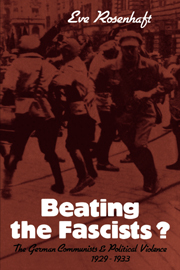Book contents
- Frontmatter
- Contents
- Preface
- List of abbreviations
- Map 1 Greater Berlin 1930
- Map 2 Central Berlin 1930
- 1 Introduction: Social crisis, radical politics and organized violence in Weimar Germany
- 2 The Party, the neighbourhood and the uses of violence in the ‘Third Period’
- 3 Defining the enemy: The wehrhafter Kampf against the SA in theory and propaganda
- 4 Organizing the wehrhafter Kampf: The Communist defence formations
- 5 Between ‘individual terror’ and ‘mass terror’: The campaign against the SA-taverns, 1931
- 6 The shape of violence in the neighbourhoods
- 7 Who were the streetfighters?
- 8 Conclusion: Communist politics in the Weimar Republic
- A note on sources
- Notes
- Bibliography
- Index
5 - Between ‘individual terror’ and ‘mass terror’: The campaign against the SA-taverns, 1931
Published online by Cambridge University Press: 05 March 2012
- Frontmatter
- Contents
- Preface
- List of abbreviations
- Map 1 Greater Berlin 1930
- Map 2 Central Berlin 1930
- 1 Introduction: Social crisis, radical politics and organized violence in Weimar Germany
- 2 The Party, the neighbourhood and the uses of violence in the ‘Third Period’
- 3 Defining the enemy: The wehrhafter Kampf against the SA in theory and propaganda
- 4 Organizing the wehrhafter Kampf: The Communist defence formations
- 5 Between ‘individual terror’ and ‘mass terror’: The campaign against the SA-taverns, 1931
- 6 The shape of violence in the neighbourhoods
- 7 Who were the streetfighters?
- 8 Conclusion: Communist politics in the Weimar Republic
- A note on sources
- Notes
- Bibliography
- Index
Summary
In the autumn of 1931 the Berlin political scene was marked by a series of attacks on taverns which were known to be frequented by members of the SA. On the ninth of September an SA-man standing guard in front of the tavern ‘Zur Hochburg’ in the Gneisenaustrasse, Kreuzberg, was shot to death in the course of such a raid. On the twelfth, shots were fired at an SAtavern in Schöneberg. The fifteenth of October brought the culmination of weeks of tension between SA and Communists in Neukölln, with a demonstration and shooting-attack against a tavern in the Richardstrasse, in the course of which the proprietor was killed. Four days later, yet another incident resulted in the crippling of a National Socialist in the Schillingstrasse, not far from the Alexanderplatz. These attacks were remarkable, in the eyes of the authorities, for the systematic use of firearms and for the fact that, unlike the majority of political brawls and even shoot-outs, they did not appear to have arisen spontaneously out of ad hoc confrontations. Their suddenness gave every appearance of careful planning.'
This series of raids arose out of efforts by the Berlin Party to put the formula of mass terror into action, and it is with an analysis of that crucial phase of the wehrhafter Kampf in the capital, the campaign against the SA-taverns which immediately preceded the promulgation of the November resolution, that our examination of the world of the Communist rank and file begins.
- Type
- Chapter
- Information
- Beating the Fascists?The German Communists and Political Violence 1929–1933, pp. 111 - 127Publisher: Cambridge University PressPrint publication year: 1983



